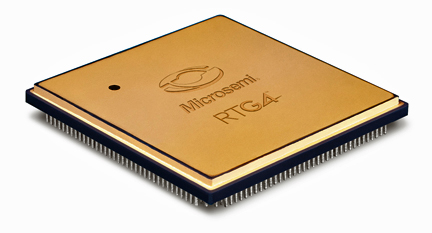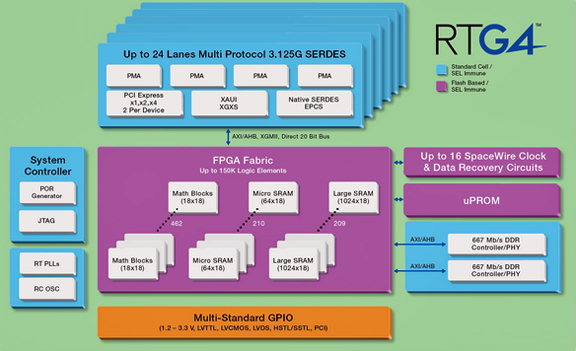[SatNews] Microsemi Corporation (Nasdaq: MSCC) has now made available their RTG4™ high-speed signal processing radiation-tolerant FPGA family.
The RTG4’s reprogrammable flash technology offers complete immunity to radiation-induced configuration upsets in the harshest radiation environments, requiring no configuration scrubbing, unlike SRAM FPGA technology. RTG4 supports space applications requiring up to 150,000 logic elements and up to 300 MHz of system performance.
Typical uses for RTG4 include remote sensing space payloads, such as radar, imaging and spectrometry in civilian, scientific and commercial applications. These applications span across weather forecasting and climate research, land use, astronomy and astrophysics, planetary exploration, and Earth sciences. Other applications include mobile satellite services (MSS) communication satellites, as well as high altitude aviation, medical electronics and civilian nuclear power plant control. Such applications have historically used expensive radiation-hardened ASICs, which force development programs to incur substantial cost and schedule risk. RTG4 allows programs to access the ease-of-use and flexibility of FPGAs without sacrificing reliability or performance. The flexibility, reliability and performance of RTG4 FPGAs make it much easier to achieve this. RTG4 is Microsemi’s latest development in a long history of radiation-tolerant FPGAs that are found in many NASA and international space programs.
Key product features include:
- Up to 150,000 logic elements; each includes a four-input combinatorial look-up table (LUT4) and a flip-flop with built-in single event upset (SEU) and single event transient (SET) mitigation
- High system performance, up to 300 MHz24 serial transceivers, with operation from 1 Gb/sec to 3.125 Gb/sec
- 16 SEU- and SET-protected SpaceWire clock and data recovery circuits
- 462 SEU- and SET-protected multiply-accumulate mathblocks
- More than 5 Mbits of on-board SEU-protected SRAM
- Single event latch-up (SEL) and configuration memory upset immunity
- Total ionizing dose (TID) beyond 100 Krad
“We expect that the next 10 years will see an increase of about 25 percent in the number of new spacecraft of 50 kg mass or larger,” said Marco Cáceres, senior analyst and director of space studies for the Virginia-based Teal Group consulting firm. “These new spacecraft will have more sophisticated payload electronics than their predecessors, doing more on-board data processing to maximize data acquisition while dealing with limited downlink bandwidth.”
David Strobel, CEO of Space Micro Inc, of San Diego, California, said, “We believe the high performance and rich feature set of the RTG4 FPGAs, together with our proprietary advanced processing algorithms, will make for a winning combination, creating great value for our space and missile customers.”
Microsemi will present more information on RTG4 FPGAs in a live webinar on May 6 and will also be hosting Microsemi Space Forum events in the U.S., India and Europe starting in June, presenting information on RTG4 FPGAs and the extensive range of Microsemi space products.




